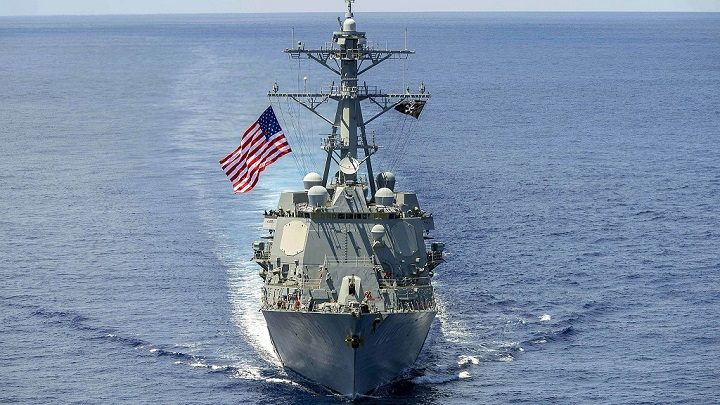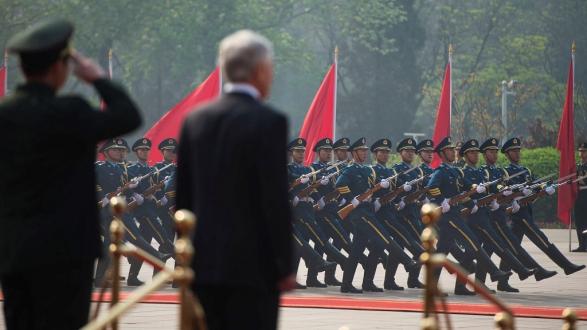In the years ahead, could a collision between American and Chinese warships in the South China Sea, or a drive toward national independence in Taiwan, spark a war between China and the United States that neither wants?
It may seem hard to imagine—the consequences would be so obviously disproportionate to any gains either side could hope to achieve. Even a non-nuclear war conducted mostly at sea and in the air could kill thousands of combatants on both sides. Moreover, the economic impact of such a war would be massive. And if a war did go nuclear, both nations would be utterly destroyed. Chinese and American leaders know they cannot let that happen.
Unwise or undesirable, however, does not mean impossible. Wars occur even when leaders are determined to avoid them. Events or actions of others narrow their options, forcing them to make choices that risk war rather than acquiesce to unacceptable alternatives. But events often require leaders to choose between bad and worse risks. And once the military machines are in motion, misunderstandings, miscalculations, and entanglements can escalate to a conflict far beyond anyone’s original intent.
The most pertinent background conditions are Thucydides’s Trap and the syndromes of rising and ruling powers that China and the United States display in full. Thucydides’s Trap is the severe structural stress caused when a rising power threatens to displace a ruling one. Most contests that fit this pattern have ended badly. Over the past 500 years, a major rising power has threatened to displace a ruling power 16 times. In 12 of those, the result was war.
The rising power syndrome highlights the upstart’s enhanced sense of itself, its interests, and its entitlement to recognition and respect. The ruling power syndrome is essentially the mirror image: the established power exhibiting an enlarged sense of fear and insecurity as it faces intimations of "decline." Understandably, the established power views the rising country’s assertiveness as disrespectful, ungrateful, and even provocative or dangerous.
China’s disruptive rise creates conditions in which accidental, otherwise inconsequential events could trigger a large-scale conflict.
Anti-satellite weapons are one accelerant that military planners expect to play a big role in any U.S.-China conflict. Long a subject of science fiction, such weapons are today a fact of life. The United States depends on satellite technology more than any of its competitors, making it a perfect target for Chinese military planners.
Cyberspace provides even more opportunities for disruptive technological transformations that could provide a decisive advantage, on the one hand, but might also risk uncontrolled escalation, on the other. America’s primary cyberspace organizations, as well as their Chinese counterparts, can now use cyber weapons to silently shut down military networks and critical civilian infrastructure like power grids. Moreover, they can disguise the origins of a cyber-operation, slowing the victim’s ability to identify the attacker.
Cyber weapons could also create a decisive advantage in battle by disrupting the command-and-control and targeting information on which modern militaries depend—and without bloodshed. This presents a dangerous paradox: the very action that attackers believe will tamp down conflict can appear reckless and provocative to the victims. Similarly, cyberattacks that disrupt communication would intensify the fog of war, creating confusion that multiplies the chances of miscalculation.
While both the United States and China now have nuclear arsenals that could survive the other’s first strike and still allow for retaliation, neither can be sure its cyber arsenals could withstand a serious cyber assault. This creates a dangerous use-it-or-lose-it dynamic in which each side has an incentive to attack key links in the other’s computer networks before their capabilities are disabled.
Potential sparks can be frighteningly mundane. Escalation can occur rapidly. The following are overviews of two of the five scenarios I detail in my book Destined for War, all of which show just how easily the United States and China can stumble into a war that each side hopes to avoid.
Scenario 1: South China Sea
Suppose that during routine operations an American destroyer passes near one of the newly constructed islands in the South China Sea where China has built runways for aircraft and installed air and missile defenses. As the ship nears the contested site, Chinese coast guard vessels harass the destroyer, just as they did during the USS Cowpens incident in 2013. Unlike that encounter, however, the U.S. destroyer is unable to swerve in time. It collides with a Chinese ship and sinks it, killing all on board.
The Chinese government decides to block the U.S. destroyer from leaving the area and demanding that its crew surrender and face justice for the deaths of the coast-guard personnel. Beijing believes it is deescalating the situation by allowing for a diplomatic solution. From a U.S. perspective, China’s reckless harassment of the destroyer caused the collision in the first place. Not willing to undermine its credibility by surrendering, the United States could use a show of force to get the cruiser to back down peacefully. Washington believes these actions will signal their seriousness without risking any further escalation. But to Beijing, the United States has already sunk a Chinese vessel and now scores of American aircraft are threatening attacks on the Chinese cruiser, other naval vessels, or military installations on nearby islands. Events are running beyond Beijing’s control.
As U.S. fighter jets rush to the scene to assist the stranded destroyer, a Chinese antiaircraft battery panics and fires on the oncoming aircraft. The destroyer begins firing on Chinese antiaircraft sites on the island. Under attack, the Chinese commander on the island bombards the destroyer with anti-ship missiles. The missiles hit their intended target, killing hundreds of American sailors and sinking the ship. Those who escape are now stranded in small lifeboats.

Chinese leaders are desperate to avoid a full-scale war with the United States, but also cannot admit that their chain of command broke down. They claim their actions were a proportionate and defensive response because the American destroyer was the aggressor. Though wary of going to war with China, U.S. officials in the Situation Room cannot back down: video of the ship’s wreckage and stranded U.S. sailors on cable news and social media has made that impossible. Realizing that attacks on China’s mainland would trigger war, the president authorizes Pacific Command to destroy China’s military bases on disputed islands in the South China Sea. The president reasons that this is a proportionate response, since these islands were directly responsible for the sinking of the destroyer. Most important, such an action would target only China’s artificial islands, leaving its mainland untouched.
Chinese officials do not make this distinction. For years they have told the public that China has undisputed sovereignty over these islands and America has just attacked them. Many in China are demanding that President Xi Jinping order the PLA to destroy U.S. military bases in Guam, Japan, and elsewhere in the Pacific. Some want China to attack the United States itself.
Still, President Xi clings to the hope that war can be avoided, an impossibility if China begins attacking U.S. military bases, killing soldiers and civilians, and triggering retaliatory attacks on the Chinese mainland. Seeking a proportionate response to the U.S. attack on China’s island bases, Xi instead approves an alternative plan: using lasers and electronic and kinetic weapons to destroy or disable all U.S. military satellites in orbit above the crisis area, and using cyberattacks to cripple American command-and-control systems throughout the Asia-Pacific. The goal is to deescalate.
The dynamics of playing chicken with cyber and space weapons over the South China Sea can transform a tiny spark into a roaring fire.
But from the American perspective, these "blinding" attacks are indistinguishable from the first stage of a coordinated attack on the U.S. aircraft carrier and its strike group sailing from Japan. The 90,000-ton carrier, a floating city of 5,500 sailors that the United States describes as sovereign American territory, is simply too big to lose. On the advice of the Joint Chiefs of Staff, the president reluctantly approves the only plan ready on short notice that has a chance of saving the carrier: a war plan based on Air-Sea Battle.
Using those assets still operational after the Chinese attack, the U.S. military begins destroying China’s various satellite and surveillance systems that allow Beijing to accurately target American carriers with its anti-ship missiles. It also launches massive cruise missile and stealth bomber attacks on PLA missile sites and air bases on the Chinese mainland, which could at any moment be used to sink U.S. vessels anywhere within the first island chain.
The attacks provoke exactly what they intended to avoid. Its mainland now under attack, and the targeting systems needed to operate China’s anti-ship weapons about to be lost, China must use them or lose them. Xi authorizes attacks on all U.S. warships within range. Enough missiles reach their target to sink the carrier, killing most of the 5,500 sailors on board—far more than died during Pearl Harbor. The dynamics of playing chicken with cyber and space weapons over the South China Sea has transformed a tiny spark into a roaring fire.
Scenario 2: Taiwan
Beijing is prepared to do whatever it takes to keep Taiwan from asserting its sovereignty. Suppose, however, that the Chinese government were to substantially increase repression at home, including in Hong Kong. Enraged that the Chinese government is backtracking on its promise to allow autonomy in Hong Kong, residents there take to the streets. Xi orders the military to do what it did in Tiananmen Square in 1989: crush the protests.
The ensuing violence shocks the Taiwanese, particularly the younger generation. Pro-independence sentiment soars. In this atmosphere, the Taiwanese president is emboldened to ramp up rhetoric emphasizing her people’s hard-won rights and democracy. To signal disapproval of Chinese regression in Hong Kong, the American president declares that the 1979 Taiwan Relations Act fully commits the United States to defend Taiwan against a Chinese invasion. This is a major break from the long-standing U.S. policy of "strategic ambiguity" on the issue.

The Taiwanese president announces that Taiwan will apply for full membership to the UN, a move that China has long opposed. To punish Taiwan’s insubordination, China barrages Taiwanese waters with "tests" of ballistic and cruise missiles, severely interrupting the commercial shipping that constitutes the island’s lifeline to the world. As a small island nation, Taiwan imports 70 percent of its food and most of its natural resources, including energy. A sustained blockade would grind its economy to a halt and cause large-scale food shortages. The United States feels obliged to prevent its strangulation.
U.S. Pacific Command offers to escort commercial shipping through the affected seas, a gesture of support but not of willingness to fight. The escort campaign puts U.S. warships at risk of being sunk by the Chinese missile barrage, either deliberately or accidentally—an event that could instantly kill more than 1,000 Americans and spark calls for retaliation. In this scenario, a Chinese anti-ship missile—ostensibly fired as part of ongoing test barrages—sinks the USS John P. Murtha, an amphibious transport dock ship acting as an escort to civilian shipping. All of the nearly 800 sailors and marines aboard are killed.
China insists that the sinking was accidental. But in Washington, the secretary of defense and the chairman of the joint chiefs urge the president to authorize the Air-Sea Battle plan to strike PLA anti-ship missile-launch sites on the mainland.
Whether Chinese and American leaders can rise to this challenge is an open question. What is certain is that the fate of the world rests upon the answer.
Because China’s conventional and nuclear missiles are kept in the same locations, and their command-and-control systems are intertwined, Beijing mistakenly believes the United States is trying to eliminate its nuclear arsenal in a surprise first strike. In a desperate attempt to "deescalate by escalating," China fires one of its land-based, nuclear-tipped ballistic missiles into an empty tract of ocean south of Okinawa. The nuclear threshold has been crossed. And while no lives have been lost in the strike, it is but a short step from here to all-out nuclear war.
War between the United States and China is not inevitable, but it is certainly possible. Indeed, as these scenarios illustrate, the underlying stress created by China’s disruptive rise creates conditions in which accidental, otherwise inconsequential events could trigger a large-scale conflict.
That outcome is not preordained: out of the 16 cases of Thucydides’s Trap over the last 500 years, war was averted four times. But avoiding war will require statecraft as subtle as that of the British in dealing with a rising America a century ago, or the wise men that crafted a Cold War strategy to meet the Soviet Union’s surge without bombs or bullets.
Whether Chinese and American leaders can rise to this challenge is an open question. What is certain is that the fate of the world rests upon the answer.
____________________
Dr. Graham Allison is the director of the Harvard Kennedy School’s Belfer Center. He previously served as Special Advisor to the Secretary of Defense under President Reagan and as Assistant Secretary of Defense for Policy and Plans under President Clinton.
This essay is adapted from his new book, Destined for War: Can America and China Escape Thucydides’s Trap? A version of this essay previously appeared in the National Interest.
The views and opinions expressed here are those of the author and do not necessarily reflect the official policy or position of the Pacific Council.



